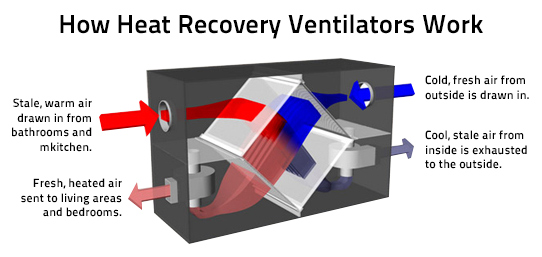Checklist: What to Consider Before Installing HRV
Wiki Article
Checking out the Benefits of Heat Recovery Ventilation for Energy Efficiency in Houses
Heat Recovery Ventilation (HRV) systems use home owners a practical approach to boosting energy performance. By reclaiming heat from outward bound air, these systems can considerably reduce heating and cooling costs. Furthermore, they provide a consistent supply of fresh air, boosting interior air quality and convenience levels. As homeowners take into consideration lasting options, recognizing the subtleties of HRV systems becomes progressively crucial. What variables should one evaluate before making such an investment?Understanding Heat Recovery Ventilation Equipments

How HRV Boosts Indoor Air High Quality

Power Cost Savings: The Economic Advantages of HRV
Taking full advantage of energy efficiency, heat recovery ventilation (HRV) systems supply significant financial advantages for house owners. By recovering and reusing heat from exhaust air, HRVs significantly minimize heating & cooling costs. This innovation can cause energy cost savings of as much as 30%, depending on climate and use patterns. Homeowners usually observe minimized utility bills shortly after installment, making HRVs a financially smart investment over time. Additionally, numerous regions give incentives or rebates for energy-efficient upgrades, further improving the economic charm. As power prices remain to rise, the cost-effectiveness of HRVs ends up being increasingly clear. Generally, the check here unification of HRV systems not only advertises power efficiency but additionally contributes to long-term monetary cost savings for houses.The Environmental Influence of Heat Recovery Ventilation
A substantial environmental benefit of heat recovery ventilation (HRV) systems exists in their ability to reduce total power intake. By recovering warmth from exhaust air and moving it to incoming fresh air, HRV systems reduce the need for energy-intensive heating and cooling down techniques. This decrease in power demand contributes to decrease greenhouse gas exhausts, as much less fossil gas is called for to keep comfy indoor temperature levels. Additionally, HRV systems enhance indoor air top quality check out this site by successfully exchanging stale air with fresh outside air, reducing reliance on mechanical cooling systems that can hurt the setting. Overall, the implementation of HRV systems sustains sustainable living techniques and straightens with worldwide efforts to battle climate adjustment by advertising energy efficiency in property settings.
Picking the Right HRV System for Your Home
Exactly how can property owners assure they pick the ideal heat recovery ventilation (HRV) system for their needs? They ought to assess their home's dimension and format, as these aspects influence air movement demands. Next off, assessing the system's performance rankings is crucial, as higher rankings indicate far better performance and power cost savings. House owners must likewise think about installation and upkeep expenses, contrasting different brand names and designs for worth. Additionally, it is necessary to review sound levels, as some systems run more quietly than others. Consulting with cooling and heating specialists can provide customized referrals based on specific home problems. Analyzing customer evaluations and service warranties can aid in making an informed choice, guaranteeing that the picked HRV system efficiently boosts indoor air high quality and energy effectiveness.Frequently Asked Concerns

How Commonly Should I Clean or Keep My HRV System?
The regularity of cleaning or maintaining a warmth recuperation air flow (HRV) system usually relies on usage and ecological variables. Typically, it is a good idea to perform upkeep every six months to assure peak efficiency and air quality.
Can HRV Solutions Aid Reduce Humidity Levels Inside?
HRV systems can properly minimize interior moisture degrees by trading stale, damp air with fresh, drier air from outdoors. HRV Heat Recovery Ventilation. This procedure helps preserve a well balanced indoor atmosphere, improving comfort and preventing moisture-related issues
What Is the Life expectancy of a Regular HRV System?
The lifespan of a common heat recovery ventilation (HRV) system differs, usually lasting in between 10 to 15 years. Normal maintenance can prolong its effectiveness and functional life, ensuring peak performance throughout its usage duration.Exist Any Kind Of Sound Issues With HRV Equipments?
Sound concerns with HRV systems can occur, especially from follower procedure. Nonetheless, many modern systems are created to decrease audio degrees, anonymous ensuring they operate silently while keeping performance, which addresses possible disruptions in living settings.Can I Install an HRV System Myself, or Do I Required a Specialist?
The specific contemplated whether to install the heat recovery ventilation (HRV) system directly or work with a specialist. Typically, while DIY setup is feasible, experience assurances proper functionality and conformity with local building regulations, improving system efficiency.Report this wiki page